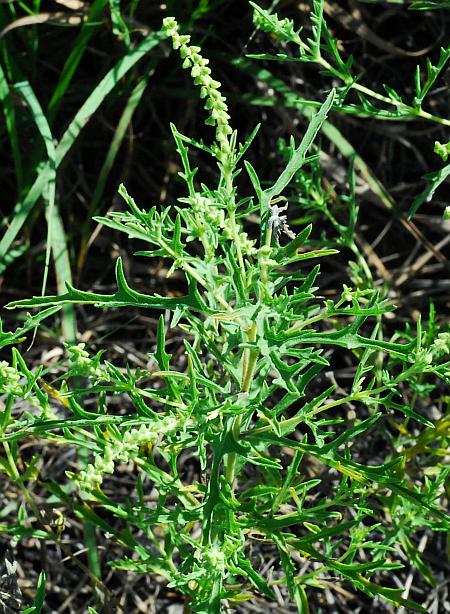Ambrosia psilostachya DC.
Western Ragweed

Native
CC = 3
CW = 3
MOC = 29
© SRTurner
Ambrosia psilostachya DC.Western Ragweed | |
 |
Native CC = 3 CW = 3 MOC = 29 |
© SRTurner |
|
Family - Asteraceae/Heliantheae Habit - Rhizomatous perennial forb. Stem - Ascending to erect, to 70 cm, moderately to densely pubescent with relatively short, appressed-ascending hairs usually with minute, pustular bases, sometimes also with longer, spreading hairs.
Leaves - Opposite, the uppermost sometimes alternate, sessile or with very short, narrowly winged petioles. Leaf blades 3-10 cm long, lanceolate to ovate in outline, mostly 1 time pinnately lobed with more than 5 lobes (the uppermost leaves sometimes with fewer lobes), the lobes narrowly lanceolate to narrowly triangular, entire or few-toothed, the surfaces moderately to densely pubescent with somewhat pustular-based hairs and often appearing somewhat grayish, the undersurface not or only slightly paler than the upper surface.
Inflorescences - Staminate heads in spikelike racemes, the staminate involucre 2-3 mm wide, with 3-9 shallow lobes, usually moderately hairy. Pistillate heads in small axillary clusters, the involucre enclosing 1 floret and with 1 beak, 2.5-3.5 mm long at fruiting, more or less ovoid, with 1 series of not or only slightly flattened, short tubercles in a ring toward the tip, these sometimes absent, moderately to densely hairy, especially above the midpoint.
Flowering - August - October. Habitat - Upland, sand, and loess hill prairies, open sandy areas. Origin - Native to the U.S. Lookalikes - Ambrosia artemisiifolia. Other info. - This smallish ragweed occurs in scattered locations throughout Missouri. It is more common in Great Plains and southwestern states. It somewhat resembles the more common ragweed in Missouri, A. artemisiifolia, but differs from that species in having less divided leaves (most being singly pinnately lobed). The plant generally has a distinctly canescent appearance (grayish due to numerous light-colored hairs). Photographs taken at St. Joe State Park, St. Francois County, MO, 8-29-2019 (SRTurner). |